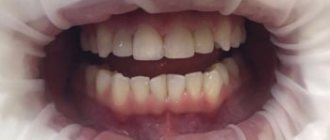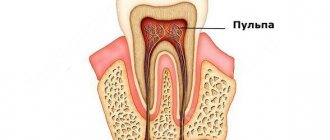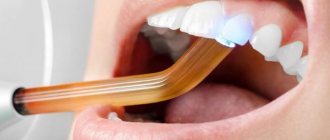What is a nerve and how many are there in a tooth?
A tooth consists of several parts. Enamel is the top, most durable layer. It protects the underlying tissue - fairly dense but porous dentin. The infection slowly destroys it and spreads beyond the crown of the tooth, into the root canals. The first thing on the way is pulp. This is a neurovascular bundle consisting of a different number (from 1 to 3) of nerve endings and blood vessels. They are the ones who nourish the tooth, maintain its strong structure and vital functions. In addition, the pulp protects the connective tissues of the periodontium from infection and immediately reports it through pain and temperature sensitivity. When the nerve is removed, the tooth is left without nutrition and protection, and therefore becomes more fragile and susceptible to chipping. It is considered dead, although it retains its functionality.
Why does deep caries develop?
The process of tooth decay under the influence of microorganisms and other factors is caries. Its onset and development is caused by the activity of pathogenic microflora of the oral cavity, in particular the bacteria Streptococcus mutans. They feed on sugars from food, cause fermentation and produce acid. It corrodes tooth tissue, which leads first to demineralization of the enamel, then to deformation of its structure and the formation of carious cavities. Gradually, the process spreads deeper and affects dentin - the bone tissue under the tooth enamel.
Caries most often does not develop at lightning speed and goes through several stages. First, a barely noticeable chalky spot forms on the enamel - an area that is different in color from the rest of the tooth. This is the area of demineralization where the carious process began. Enamel loses the mineral compounds that make up its structure, becomes more fragile and less resistant to harmful influences. This is the initial stage of caries - the spot stage. People often miss it due to the lack of obvious symptoms. Then tooth decay continues, and the disease progresses to the stage of superficial caries. The tooth begins to react to hot/cold, sour/sweet, and a clear defect is noticeable in the enamel.
Without treatment, superficial caries progresses to intermediate caries when dentin begins to deteriorate. Symptoms become more pronounced, pain occurs not only as a reaction to an irritant, but also on its own. According to statistics, most patients seek help from a dentist at the stage of average caries.
But there are also people whom even acute toothache will not force them to go to the dentist. And then the most complex and advanced form can develop - deep caries. At this stage, the carious cavity is in close proximity to the dental pulp; at any moment, inflammation can spread to the dental nerve and lead to pulpitis, and then to periodontitis.
How to remove a nerve from a tooth
A couple of decades ago, the only way to remove a nerve from a tooth was with arsenic.
After treating the caries, it was applied to the exposed area of the pulp and a temporary filling was placed. You had to walk with arsenic paste on your tooth for several days for the nerve to die. The danger was that arsenic is a poison that affects the health of the entire body. And with prolonged contact with the tooth, it could be completely destroyed. Modern methods of treating pulpitis and removing the nerve are harmless.
The doctor makes an accurate diagnosis and determines the area of inflammation in the tooth. Then he injects an anesthetic to make the procedure painless. The specialist thoroughly cleans the root canals and removes affected tissue to prevent re-inflammation. If necessary, he applies arsenic-free medicine under a temporary filling, and then replaces it with a permanent one and takes a control photograph. Most often, tooth nerve removal takes place in one session, with a permanent filling immediately installed. It is impossible to carry out treatment without complete removal of the pulp (in adults), since its damage is an irreversible process.
Surgical method
The dentist’s task is to completely clean out the affected nerve from the canals when treating pulpitis.
In this case, treatment of pulpitis involves excision or complete removal of the affected pulp. Removing only the crown part will not work for teeth with one root due to the structure of the nerve. In addition, there are certain restrictions on the age of patients and the presence of allergic reactions.
If the pulp was partially removed, the doctor will also use medications to preserve the remaining part of the nerve.
With complete removal - under anesthesia or using a devitalizing paste - the nerve is completely removed from the tooth, including the root canals.
- Treatment of pulpitis in stages means that it is important for the doctor to remove the tissue completely to avoid recurrence of the infection.
- Afterwards, the canals and the tooth cavity are filled and everything is closed with a permanent filling.
After filling the canals, an x-ray must be taken to check the absence of voids; the cavities are etched and dried to ensure high-quality adhesion of the material to the tooth tissues and to prevent the filling from falling behind after hardening.
Tooth hurts after nerve removal
After treatment and the end of anesthesia, the pulpless tooth may hurt. The reason may be temporary, since removal of the nerve is a serious intervention in the structure of the tooth. Usually, after a few days, all unpleasant symptoms disappear. If after two weeks the tooth continues to ache, and the pain even intensifies, consult your doctor immediately. Perhaps it’s all about the neighboring tooth, the pain from which radiates to the recently cured one.
Surgery
The surgical method of treating pulpitis involves removing the nerve and comes in several types: vital and non-vital. In the first case, the indications are the following: the presence of focal inflammation, acute diffuse pulpitis and pulpitis in the chronic stage (fibrous or hypertrophic).
Pulp removal is performed by an experienced specialist and only under local anesthesia. First of all, the pulp chamber is opened and treated with powerful antiseptic drugs. To extract the top of the chamber, a special tool called a pulp extractor is used, only after this can you begin to remove the root section.
The method, which involves preliminary destruction of the pulp, is based on the use of a special composition - depulpin. This option is considered optimal for patients who are panicky about anesthesia injections and pain. It is also suitable for people who have allergic reactions to the painkillers used.
Stages of treatment
Diagnostics. Before removing the nerve, the dentist takes x-rays. The image allows you to assess the condition, number and structure of the root canals, decide on the need to remove the nerve, and plan the procedure.
Anesthesia. For pain relief, conduction anesthesia is used (injection is performed). In case of severe inflammation and severe pain, local anesthesia at the injection site can be additionally used.
Preparation of the working field. After opening the hard tissues, the tooth must be protected from saliva containing bacteria getting inside. To do this, the working field is isolated with latex strips (cofferdam). During further treatment, this insulation protects the mucous membranes from heating by polymerization lamps.
Processing of hard tissues. Performed after injuries, carious lesions, destruction, etc. The damaged tissue is removed, and the dentist creates an opening in the tooth to access the pulp. During treatment, the tooth is cooled with an air-water mixture to prevent overheating of its tissues. After removing the affected tissue, the walls of the pulp chamber are treated in such a way as to increase the reliability of subsequent filling.
Nerve removal. Performed with a pulp extractor. This is a dental instrument that looks like a needle with small teeth. A pulp extractor is placed in the canal, the nerve is wound around it and removed. This is a disposable tool. In some cases, instruments for cutting pulp tissue can be used instead.
Root canal treatment. Measuring their length, cleaning, treating with an active antiseptic. Needed to remove residual pulp and other particles.
Installation of a temporary filling. Performed as an intermediate stage of treatment. A permanent filling is not placed immediately so that the dentist has the opportunity to check the condition of the root canals during the next visit, before permanent filling or crown installation.
Taking a control shot. It is necessary to make sure that the canals are properly processed and completely sealed.
What complications may occur after treatment?
Among the most common undesirable consequences that can be encountered after depulpation are the following:
The pulp was not completely removed or the canals were not completely sealed. This dental error leads to inflammation and requires repeated endodontic treatment. If it is not carried out, a cyst may form or periodontitis or gumboil may occur.- A fragment of a dental instrument remained in the dental canal. This problem is always caused by low qualifications or inexperience of the dentist. You need to take a picture and refill the canals. Otherwise, the tooth will continue to hurt. However, if the complication does not manifest itself in any way (the patient found out about it by chance while taking an X-ray about a neighboring tooth), re-treatment may not be necessary.
- Resealing. The essence of this complication is that the filling composition used by the doctor extends far beyond the top of the tooth root. If the amount of excess is small, pain occurs when pressing on the tooth; if it is significant, severe discomfort sensations persist on an ongoing basis. In any case, surgical treatment is necessary to remove all excess.
- Change in crown color. The tooth darkens after the nerve is removed if low-quality filling material is used. The second reason is that a dead unit becomes covered with microcracks over the years. Coloring pigment accumulates in them. This causes a change in the natural shade.
- Puncture (perforation) of the tooth wall or root. Always caused by mechanical damage. The problem requires a surgical approach.
It is important to understand that these complications are rare. If you have chosen an experienced doctor and a good dental clinic, you can rest assured about the health of the tooth being treated.
Treatment of tooth pulpitis: methods
Treatment of pulpitis is most often carried out by depulping the tooth. This method involves completely removing the nerve in the tooth, after which the doctor mechanically expands and then fills the root canals. In young patients (provided they apply at an early stage of inflammation), it is possible to carry out treatment while preserving the living pulp of the tooth.
Of course, it is best to leave the nerve alive, because pulpless teeth become more fragile and also change their color to a grayer color. However, in most cases, the use of biological methods for treating pulpitis is impossible, because Patients extremely rarely apply at the very beginning of pulp inflammation (when the first symptoms have just appeared). Age also plays a decisive role in the choice of this method - this method is indicated for use only in people under 25-27 years of age.
Below we will talk in detail about the traditional treatment of pulpitis (read about the conservative method in the link above). By the way, according to official statistics, treatment of pulpitis is carried out poorly in 60-70% of cases, which requires subsequent retreatment of the tooth. This is due to poor-quality root canal filling.











